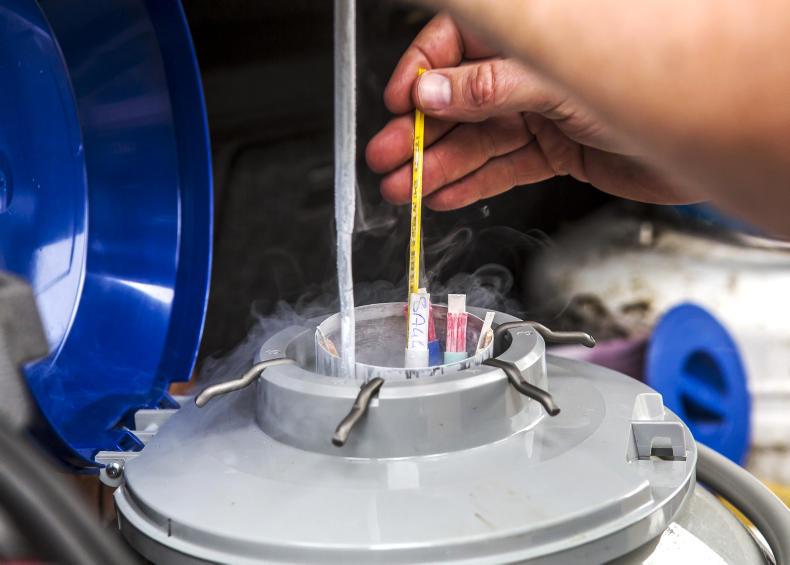Stephen Butler, the reproduction researcher in Teagasc Moorepark describes his research on sexed semen results on farms as being in three sections:
One third of farmers in the study achieved really good results being equal to or better than conventional semen, one third achieved results that you would expect i.e. an acceptable reduction in conception rates while the final third achieved poor results.
Considering the protocol for selecting cows to get sexed semen across the trial herds was all the same, the timing of AI was the same and the sexed semen itself was all the same then the implication is that the variation in performance is all down to the technician.
This is unpalatable news for AI companies, but what other explanation could there be for the variation in results?
It’s important to discuss this now as I’m hearing of strong demand for sexed semen this season.
The Teagasc guidelines for the handling of sexed semen have been well documented and are presented below;
Organise sexed straws into one goblet. Thaw a maximum of two sexed semen straws at a time.Thaw straws at 35°C to 37 °C for 45 seconds.Load straws into pre-warmed AI guns and keep warm. Deposit semen in uterine body.Complete inseminations within five minutes.These guidelines are not too different to the guidelines for using conventional semen. However, it’s fair to say that a good few AI technicians and DIY AI operators have strayed from the guidelines for handling conventional semen, without impacting on conception rates.
Things such as thawing four or five straws at a time, not thawing in warm water or not pre-heating AI guns are common enough practices in a lot of cases.
Sexed semen is a very different product to conventional semen.
However, if these practices are used with sexed semen the conception rates will be poor. Sexed semen is a very different product to conventional semen.
It’s a damaged product with less than half the number of viable sperm cells compared to conventional semen. It needs everything to be in its favour for the sperm to meet the egg.
The reason AI technicians get a little bit lax around the protocols for handling conventional semen is because they are very busy and need to get through hundreds of cows a day when at peak.
This begs the question if AI technicians are the right people to be carrying out sexed semen. Is it fair to ask them to spend longer serving a cow with sexed semen. Should AI technicians be charging more for sexed semen inseminations. I know in some cases they are.
The key message is, if your technician is not willing or able to follow the correct protocol for sexed semen, then leave it in the flask.
Read more
Sexed semen: can it be more profitable?
Building the picture of heat detection
Stephen Butler, the reproduction researcher in Teagasc Moorepark describes his research on sexed semen results on farms as being in three sections:
One third of farmers in the study achieved really good results being equal to or better than conventional semen, one third achieved results that you would expect i.e. an acceptable reduction in conception rates while the final third achieved poor results.
Considering the protocol for selecting cows to get sexed semen across the trial herds was all the same, the timing of AI was the same and the sexed semen itself was all the same then the implication is that the variation in performance is all down to the technician.
This is unpalatable news for AI companies, but what other explanation could there be for the variation in results?
It’s important to discuss this now as I’m hearing of strong demand for sexed semen this season.
The Teagasc guidelines for the handling of sexed semen have been well documented and are presented below;
Organise sexed straws into one goblet. Thaw a maximum of two sexed semen straws at a time.Thaw straws at 35°C to 37 °C for 45 seconds.Load straws into pre-warmed AI guns and keep warm. Deposit semen in uterine body.Complete inseminations within five minutes.These guidelines are not too different to the guidelines for using conventional semen. However, it’s fair to say that a good few AI technicians and DIY AI operators have strayed from the guidelines for handling conventional semen, without impacting on conception rates.
Things such as thawing four or five straws at a time, not thawing in warm water or not pre-heating AI guns are common enough practices in a lot of cases.
Sexed semen is a very different product to conventional semen.
However, if these practices are used with sexed semen the conception rates will be poor. Sexed semen is a very different product to conventional semen.
It’s a damaged product with less than half the number of viable sperm cells compared to conventional semen. It needs everything to be in its favour for the sperm to meet the egg.
The reason AI technicians get a little bit lax around the protocols for handling conventional semen is because they are very busy and need to get through hundreds of cows a day when at peak.
This begs the question if AI technicians are the right people to be carrying out sexed semen. Is it fair to ask them to spend longer serving a cow with sexed semen. Should AI technicians be charging more for sexed semen inseminations. I know in some cases they are.
The key message is, if your technician is not willing or able to follow the correct protocol for sexed semen, then leave it in the flask.
Read more
Sexed semen: can it be more profitable?
Building the picture of heat detection






 This is a subscriber-only article
This is a subscriber-only article










SHARING OPTIONS: